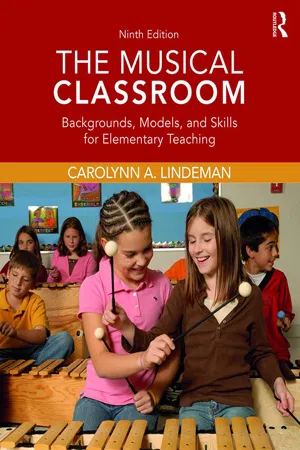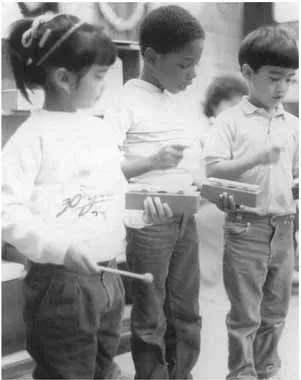
The Musical Classroom
Backgrounds, Models, and Skills for Elementary Teaching
- 402 pages
- English
- ePUB (mobile friendly)
- Available on iOS & Android
About this book
The Musical Classroom: Backgrounds, Models, and Skills for Elementary Teaching, Ninth Edition, is designed for students majoring in elementary or music education. Through eight editions, this book has been a market leader in its field. Its goal has been to help teachers—some who may only have a limited background in music—prepare to make music a part of the daily lives of their students. The model lessons remain the centerpiece of the book's long-lasting success. Supported by a collection of children's songs from around the world, instructional information for learning to play basic instruments, and the theoretical, pedagogical, and practical backgrounds needed for reaching all learners, pre-service and in-service teachers can make their classrooms musical classrooms.
NEW to the ninth edition:
- The 2014 National Core Music Standards
- Multiple curricular connections to other subjects
- Expanded soprano recorder instruction unit
- Addition of the QChord® with Autoharp®/Chromaharp® instruction unit
- Updated and expanded prekindergarten section
- A significant infusion of technology throughout the text
- Mallet-instrument ensemble accompaniments
- A companion website linking to music sources with numerous resources for both students and instructors
Frequently asked questions
- Essential is ideal for learners and professionals who enjoy exploring a wide range of subjects. Access the Essential Library with 800,000+ trusted titles and best-sellers across business, personal growth, and the humanities. Includes unlimited reading time and Standard Read Aloud voice.
- Complete: Perfect for advanced learners and researchers needing full, unrestricted access. Unlock 1.4M+ books across hundreds of subjects, including academic and specialized titles. The Complete Plan also includes advanced features like Premium Read Aloud and Research Assistant.
Please note we cannot support devices running on iOS 13 and Android 7 or earlier. Learn more about using the app.
Information
Section II
Model Experiences for Teaching Music
- 8 INTRODUCTION TO MODEL EXPERIENCES FOR TEACHING MUSIC
- 9 LEVEL I: KINDERGARTEN AND FIRST GRADE
- 10 LEVEL II: SECOND AND THIRD GRADES
- 11 LEVEL III: FOURTH AND FIFTH GRADES
8
Introduction to Model Experiences for Teaching Music
- ∎ Scope and Sequence Chart of Music Concepts in Model Experiences, Levels I-III
- ∎ Developmental Characteristics of Kindergarten-5th-Grade Students
- ∎ The Model Experience Format
- ∎ Suggestions for Model Experience Presentations
- ∎ Teaching Tips

Introduction to Model Experiences for Teaching Music

Table of contents
- Cover
- Title
- Copyright
- Dedication
- Brief Contents
- Contents
- ABOUT THE AUTHOR
- PREFACE
- ACKNOWLEDGMENTS
- SECTION I Backgrounds for Teaching Music
- SECTION II Model Experiences for Teaching Music
- SECTION III Songs
- SECTION IV Appendices
- GLOSSARY
- SUBJECT INDEX
- MUSIC INDEX